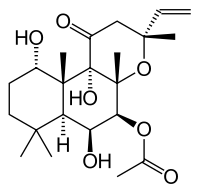All AbMole products are for research use only, cannot be used for human consumption.

Forskolin (also called Coleonol) is a naturally occurring diterpene that is produced by the Indian Coleus plant (C. forskohlii). Forskolin is commonly used to raise levels of cAMP in a wide variety of intact cells and tissue preparations. Forskolin binds to adenylyl cyclase in membranes from stably transfected Sf9 cells expressing type 1 adenylyl cyclase with an IC50 value of 41 nM and demonstrates an EC50 value of 0.5 μM in an activation assay assessing formation of cAMP from ATP. Forskolin can activate or upregulate the proliferation of Schwann cells in culture, together with Fibroblast growth factor or Transforming Growth Factor-Beta. Forskolin also interacts with glucose transporters and certain ion channels and has been used for examining adenylyl cyclase expression, regulation, and G protein signaling.

Patent. CN119639678A 2025 Mar 18.
Patent. CN119639678A
Forskolin purchased from AbMole

Cancer Lett. 2024 Oct 02;605:217284.
Exploring epigenetic dynamics unveils a super-enhancer-mediated NDRG1-β-catenin axis in modulating gemcitabine resistance in pancreatic cancer
Forskolin purchased from AbMole

Biochem Pharmacol . 2023 Jan;207:115355.
Inhibition of deubiquitinase USP28 attenuates cyst growth in autosomal dominant polycystic kidney disease
Forskolin purchased from AbMole

Patent. CN116987669A 2023 Nov 03.
Patent. CN116987669A
Forskolin purchased from AbMole

Biochem Pharmacol. 2022 Nov 25;115355.
Inhibition of deubiquitinase USP28 attenuates cyst growth in autosomal dominant polycystic kidney disease
Forskolin purchased from AbMole

Acta Histochem. 2022 Aug;124(6):151931.
Fibroblast-derived exosomal miRNA-133 promotes cardiomyocyte-like differentiation
Forskolin purchased from AbMole

Biochem Biophys Res Commun. 2020 Apr 30;525(2):326-333.
Spexin as an Anxiety Regulator in Mouse Hippocampus: Mechanisms for Transcriptional Regulation of Spexin Gene Expression by Corticotropin Releasing Factor
Forskolin purchased from AbMole
| Molecular Weight | 410.51 |
| Formula | C22H34O7 |
| CAS Number | 66575-29-9 |
| Solubility (25°C) | DMSO 50 mg/mL Ethanol 20 mg/mL |
| Storage | 2-8°C, protect from light |
| Related Adenylate Cyclase Products |
|---|
| AC1-IN-1
AC1-IN-1 is a potent and selective Adenylyl cyclase type 1 (AC1) inhibitor with an IC50 of 0.54 µM. |
| TDI-11861
TDI-11861 is second-generation soluble Adenylyl Cyclase (sAC, ADCY10) inhibitor with slow dissociation rates. |
| Small Cardioactive Peptide B (SCPB)
Small Cardioactive Peptide B (SCPB), a neurally active peptide, stimulates adenylate cyclase activity in particulate fractions of both heart and gill tissues with EC50s of 0.1 and 1.0 μM, respectively. |
| TIP 39, Tuberoinfundibular Neuropeptide
TIP 39, Tuberoinfundibular Neuropeptide is a neuropeptide and parathyroid hormone 2 receptor (PTH2R) agonist. |
| PACAP (6-27) (human, ovine, rat)
PACAP (6-27) (human, ovine, rat) is a PACAP receptor antagonist that blocks the canine adrenal catecholamine response to exogenous vasoactive intestinal peptide (VIP). |
All AbMole products are for research use only, cannot be used for human consumption or veterinary use. We do not provide products or services to individuals. Please comply with the intended use and do not use AbMole products for any other purpose.


Products are for research use only. Not for human use. We do not sell to patients.
© Copyright 2010-2024 AbMole BioScience. All Rights Reserved.
